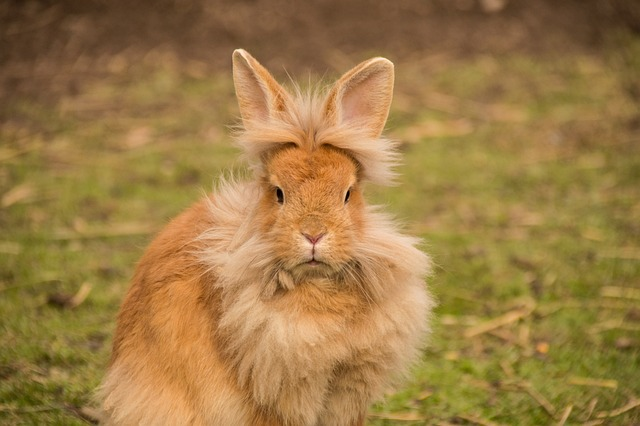Bathing a rabbit may seem like an impossible task, but it can actually be done with the right preparation and technique. While rabbits are generally clean animals that groom themselves regularly, there are certain circumstances when they need a little extra help to stay clean and healthy. In these cases, bathing your rabbit is not only possible but necessary.
In this article, we’ll explain why you might need to bathe your bunny and provide step-by-step instructions on how to do it safely and effectively. We’ll also discuss what tools you’ll need for the job as well as any potential risks or complications you should look out for along the way. By the end of this article, you should have all the information needed to give your furry friend a proper bath!

Reasons why you should bathe your rabbit
There are several reasons why you may need to bathe your rabbit from time to time. It’s important to understand these reasons so that you can ensure your pet is getting the best possible care.
1. To Remove Grease and Dirt: This is one of the most common reasons for bathing a rabbit as most rabbits will groom themselves quite often, but sometimes they can’t get everything off. In these cases, a bath with warm water and a gentle shampoo can help remove any dirt or grease that has built up over time.
2. To Remove Allergens: If your rabbit suffers from allergies, bathing them regularly can help reduce the allergens in their fur. This is especially important if your rabbit spends a lot of time outdoors or is exposed to other animals.
3. To Soothe Skin Ailments: Sometimes rabbits can get skin ailments like eczema, which can be itchy and uncomfortable for them. Bathing them with a medicated shampoo can help soothe these symptoms and give them some relief.
4. To Reduce Shedding: Regularly bathing your rabbit can help reduce the amount of fur that they shed, which can be helpful for people who have allergies or sensitive skin. This is because bathing helps remove loose hairs and prevent them from being spread around the house.
Preparing for a bath – what supplies are needed?
Before you start bathing your rabbit, it’s important to make sure you have all the necessary supplies. Here is a list of items that are helpful to have on hand:
– A bathtub or sink
– A towel
– Shampoo and conditioner specifically designed for rabbits
– Cotton balls or tissues for cleaning ears
– A spray bottle filled with warm water
– An additional towel for drying off your rabbit
– Some treats as a reward afterward
How to safely handle and hold your rabbit during the bath
Now that you have all the necessary supplies, it’s time to learn how to properly handle and hold your rabbit during their bath. Here are some tips for safely handling your bunny:
– Start by gently placing one hand under their chest and the other over their back. This will help keep them secure while still allowing them to move freely.
– Avoid grabbing their fur as this can be uncomfortable and even painful for them.
– Speak in a calming voice to reassure your pet throughout the process.
– Make sure that you keep your rabbit’s head above water at all times to prevent any water from getting into their ears or eyes.
Choosing the right shampoo and conditioner for your rabbit’s coat type
Once you have all the necessary supplies and know how to safely handle your pet, it’s time to pick out a shampoo and conditioner. This is an important step since not all products are created equal. There are several types of shampoos that are specifically designed for rabbits:
– Oatmeal Shampoo: This type of shampoo is an ideal solution for rabbits with sensitive skin or allergies. It helps to soothe itchiness and redness on rabbit skin while also providing moisture to the coat.
– Shed Control Shampoo: This type of shampoo helps reduce shedding by removing excess fur from your rabbit’s coat. It’s great for owners who have allergies or sensitive skin as it prevents too much hair from circulating in the air.
– Deodorizing Shampoo: This type of shampoo is perfect for rabbits that have an odor to their coat or get smelly after long periods without a bath. It helps to neutralize odors and keep your rabbit’s feet always smelling fresh.
Step-by-step instructions on how to give your rabbit a bath
Now that you have the supplies and know how to safely handle your rabbit, it’s time to give them a bath! Here is a step-by-step guide on how to do so:
Start by filling up the bathtub or sink with lukewarm water. Make sure that it’s not too hot or cold as this can be uncomfortable for your rabbit.
Gently place your pet in the water and wet their fur with a spray bottle filled with warm water. Make sure to keep their head above the water at all times.
Apply shampoo specifically designed for rabbits and work it into a lather. Avoid getting any shampoo in their eyes or ears.
Rinse the shampoo off thoroughly with lukewarm water and then apply conditioner, if desired.
Once your bunny is clean, use a towel to dry them off before placing them back into their cage or hutch.
As a reward for good behavior, offer your rabbit some treats for a job well done!
Giving your rabbit regular baths is an important part of keeping them healthy and clean. With these tips, you’ll be able to give your pet the best care possible!
Tips on drying off, brushing, and combing out any knots or tangles in their fur after the bath
After you’ve given your rabbit a bath, it’s important to make sure they are properly dried off and their fur is free from any knots or tangles. Here are some tips on how to do so:
– Use a soft towel to gently pat dry your pet’s wet fur, after the bath. Make sure that you don’t rub them too hard as this can be uncomfortable for them.
– Gently brush and comb gently work out any knots or tangles that may have formed in their fur during the bath. This helps to prevent further matting and discomfort for your rabbit.
– Follow up with a hairdryer and some light brushing and combing to make sure all of the furs are laying smooth.
– Offer your pet a snack or treat to reward them for being so well-behaved throughout the process!
Common mistakes people make when bathing their rabbits (e.g., using too hot
water)
When it comes to bathing your rabbit, there are several common mistakes that people often make. Here are some of the most common mistakes that you should avoid:
Using too hot or cold water: Always make sure that the water is lukewarm before placing your pet in the tub. This helps to prevent any discomfort for them and ensures that the bath is enjoyable.
Not wetting their fur enough: Before using any shampoo, make sure to fully wet your rabbit’s fur with a spray bottle filled with lukewarm water. This helps to ensure that the shampoo will effectively clean their coat.
Not rinsing off all of the shampoos: Make sure to rinse off all of the shampoo and conditioner before taking your pet out of the tub. Any residue that is left behind can cause skin irritation or discomfort.
Not drying them off completely: Use a soft towel to pat dry your rabbit’s fur after the bath. This helps to prevent any chills or discomfort from setting in and keeps

Signs that indicate it may be time for a professional groomer to bathe your rabbit
If you find that your rabbit’s coat is becoming excessively greasy or matted, it may be time to seek out professional grooming services. Here are some signs that indicate it may be time to seek help from a groomer:
Excessive greasiness in their fur: If your pet’s fur is noticeably greasy and difficult to manage, it may be time for a professional groomer to give them a bath.
Excessive matting or tangles in their fur: If your pet’s fur is becoming matted or tangled, chances are that they need a good grooming session. Professional groomers have the knowledge and experience to carefully brush out any knots or tangles in their fur.
Skin irritation or discomfort: If your pet is exhibiting any signs of skin irritation or discomfort, this may indicate that they need a professional groomer to give them a bath. Groomers are trained to handle these types of situations and can help provide relief for your furry friend.
What products can help keep your rabbit clean between baths?
In between baths, there are several products that can help keep your rabbit’s rump really clean and healthy. Here are some helpful products:
Deodorizing sprays: Deodorizing sprays can help to reduce any unwanted odors in your pet’s fur.
Anti-dander shampoos: Anti-dander shampoos are specially formulated to help reduce the amount of dander on your pet’s fur.
Conditioners: Conditioners can help to keep your rabbit’s coat soft and smooth in between baths.
Grooming brushes: Grooming brushes can be used to help remove any excess dirt or debris from your pet’s fur.
These products can help keep the skin type of your rabbit clean and comfortable in between baths. Be sure to use them as directed in order to get the best results!
Additional health benefits of regular bathing for rabbits
In addition to keeping their fur clean and healthy, regular baths can also help to provide several other health benefits for your rabbit. Here are some of the additional benefits of regular bathing:
Improved circulation: A warm bath helps to stimulate blood flow throughout your pet’s body, which can improve overall circulation.
Better immune system function: Bathing helps to remove any bacteria or dirt that may be present on your pet’s fur, which can help to improve their overall immune system function.
Reduced stress: The warm water and soothing massage of a bath can help to reduce stress levels in your pet. This can have a positive effect on their overall health and well-being.
Regular bathing can provide numerous health benefits for your rabbit, so make sure to include it in your pet care routine. Your furry friend will thank you!
Signs of stress to watch out for when bathing your rabbit
When bathing your rabbit, it is important to pay attention to any signs of stress. Here are some signs that may indicate that your pet is feeling stressed or uncomfortable:
Excessive panting: If your rabbit begins to pant excessively during their bath, this could be a sign of distress.
Hiding or trying to escape: If your pet begins to hide or tries to escape from the bath, vet say this could be a sign of stress.
Shedding more than usual: If your rabbit is shedding more than usual during their bath, it could be an indication that they are feeling stressed.
If you notice any of these signs while bathing your rabbit, take a break and allow them to relax. It is important to make sure that your pet feels comfortable in order to avoid any potential stress or anxiety.
How often should you bathe your rabbit?
Rabbits should typically only be given a bath once every few months. Overbathing can cause skin dryness and irritation, so it is important to be mindful of how often you wash and bathe them. Additionally, rabbits are naturally clean animals and usually do not need frequent baths.
It is also important to use specially formulated products when bathing your pet. Regular human shampoos can be too harsh for your rabbit’s fur and can cause dryness or irritation. When bathing your rabbit’s skin, make sure to use products specifically designed for them in order to keep their fur healthy and soft.
What kind of water temperature is best for bathing rabbits?
When bathing your rabbit, it is important to make sure that the water temperature is comfortable for them. The ideal temperature should be between 85-95°F (29-35°C). Make sure to test the water with your hand before introducing it to your pet in order to ensure that it is not too hot or cold.
When should you avoid bathing your rabbit?
In some cases, it may be best to avoid giving your rabbit a bath. If your pet is sick or injured, this could further aggravate their condition and delay healing. Additionally, if the weather outside is cold, it may be best to postpone the bath until the temperature has warmed up.
It is also important to avoid bathing a pregnant rabbit as this could cause additional stress. This can be detrimental to both the mother and her unborn babies.
is it necessary to use a special shampoo when bathing my rabbit?
Yes, it is important to use a special pet shampoo, when bathing your rabbit. Regular human shampoos can be too harsh for a rabbits fur, and can cause dryness or irritation. When bathing your pet, make sure to use products specifically designed for them in order to keep their fur healthy and soft. Additionally, make sure to avoid any shampoos that contain harsh chemicals or fragrances.
It is also important to rinse thoroughly after bathing in order to remove any soap residue which can irritate your rabbit’s delicate skin further. Finally, make sure to dry your pet completely with a towel before allowing them back into their cage.
Can I bathe my baby bunny or should they wait until they are older?
It is best to wait until your baby bunny is at least 6-8 weeks old before bathing them. Baby bunnies can be very delicate and a bath may cause additional stress on their developing bodies. Additionally, they do not need regular baths as much as adult rabbits since they are naturally clean animals. However, if an emergency situation arises, you can bathe a baby bunny as long as the water temperature is comfortable and you use a gentle shampoo specifically designed for rabbits.
What to do if your rabbit is not enjoying the bath?
If your rabbit is not enjoying their bath, there are a few things you can do to make the experience more pleasant. Firstly, try using toys or treats as a distraction while bathing them. This will help to divert their attention away from the water and onto something else. Additionally, you can take breaks between washings if your pet begins to show signs of distress. Finally, make sure to reward your pet after the bath with a treat or extra cuddle time.
Do bunnies like dry baths?
Many bunnies actually enjoy dry baths. Dry baths involve using a damp cloth to gently rub their fur and remove any dirt or debris that has built up. This method is much less stressful than giving them a wet bath and can help keep their fur soft and clean without the need for harsh soaps or shampoos. If you choose to use a dry bath, make sure to use gentle, circular motions and not scrub too hard. Additionally, avoid using any oils or other products as these can irritate your rabbit’s skin.
In Conclusion
Bathing your rabbit should be done with care and consideration. It is important to only bathe them once every few months, use specially formulated products designed for rabbits, and make sure that the water temperature is comfortable for them. Additionally, it may be best to avoid bathing a pregnant rabbit or young baby bunny until they are older as this could cause additional stress on their developing bodies. Finally, if your pet does not seem to enjoy the bath experience you can try using toys or treats as a distraction while also taking breaks between washings and rewarding them afterwards with a treat or extra cuddle time. With these tips in mind, you will be able to give your furry friend an enjoyable bath experience!



